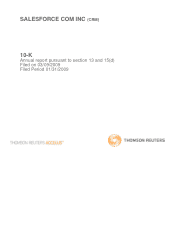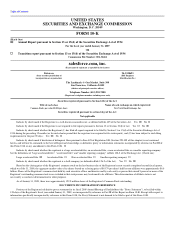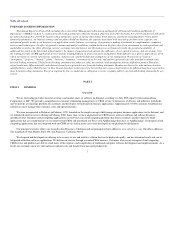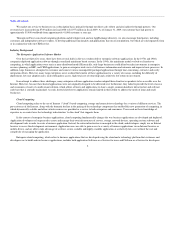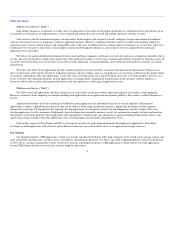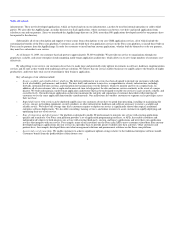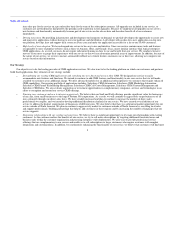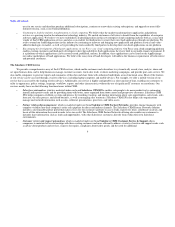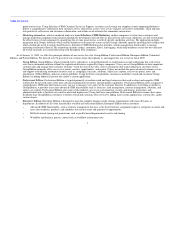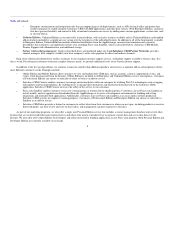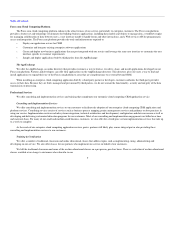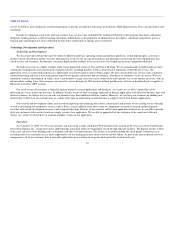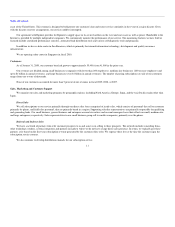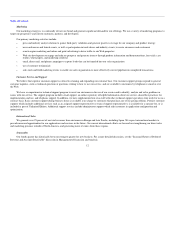Salesforce.com 2008 Annual Report Download - page 5
Download and view the complete annual report
Please find page 5 of the 2008 Salesforce.com annual report below. You can navigate through the pages in the report by either clicking on the pages listed below, or by using the keyword search tool below to find specific information within the annual report.
Table of Contents
We market our service to businesses on a subscription basis, primarily through our direct sales efforts and also indirectly through partners. Our
revenues have increased from $749 million in fiscal 2008 to $1,077 million in fiscal 2009. As of January 31, 2009, our customer base had grown to
approximately 55,400 worldwide from approximately 41,000 customers a year ago.
Through our Force.com cloud computing platform and developer tools and our AppExchange directory, we also encourage third parties, including
customers and independent software vendors, to develop additional functionality and applications that run on our platform, but which are sold separately from
or in conjunction with our CRM service.
Industry Background
The Enterprise Application Software Market
Over the last thirty-five years, there have been several shifts in the way vendors deliver enterprise software applications. In the 1970s and 1980s,
companies deployed application software through centralized mainframe based systems. In the 1990s, the mainframe model evolved to client/server
computing, in which applications were run in a more distributed model. Historically, only large businesses could afford to make investments in enterprise
resource planning, or ERP, and CRM applications, to gain an enterprise-wide view of all business information and automate and improve basic processes. In
addition, large businesses attempted to customize and connect various incompatible packaged applications through time-consuming, extensive and costly
integration efforts. However, many large enterprises never realized the benefits of these applications for a variety of reasons, including the difficulty of
deployment, low user adoption rates, lack of ubiquitous access, high total cost of ownership and a relatively low return on investment.
In an attempt to address these challenges, many enterprise software application vendors adapted their client/server products to be accessible over the
Internet. However, because these hosted applications were not originally designed to be delivered over the Internet, they failed to provide the level of access
and economies of scale of a multi-tenant solution, which allows all users and applications to share a single, common hardware infrastructure and software
code base that is centrally maintained. As such, hosted client/server applications remain limited in their ability to address the needs of large and small
businesses.
Cloud Computing
Cloud computing refers to the use of Internet ("cloud") based computing, storage and connectivity technology for a variety of different services. The
pervasiveness of the Internet, along with the dramatic decline in the pricing of the technology components has enabled this new generation of computing, in
which dynamically scalable and often virtual resources are provided as a service to both enterprises and consumers. Users need not have knowledge of,
expertise in, or control over the technology infrastructure "in the cloud" that supports them.
In the context of enterprise business applications, cloud computing fundamentally changes the way business applications are developed and deployed.
Application developers no longer need to create and manage their own infrastructure of servers, storage, network devices, operating system software and
development tools in order to create a business application. Instead, the entire infrastructure is managed in the cloud, and developers simply use an Internet
browser to access the development environment. Application users are able to gain access to a variety of business applications via an Internet browser or
mobile device, and are able to take advantage of a robust, secure, scalable and highly available application at a relatively low cost, without the cost and
complexity of managing the application.
Enterprise cloud computing, which refers to business applications that are developed using the cloud and a technology platform that customers and
developers use to build and run business applications, includes both application Software-as-a-Service for users and Platform-as-a-Service for developers.
2

